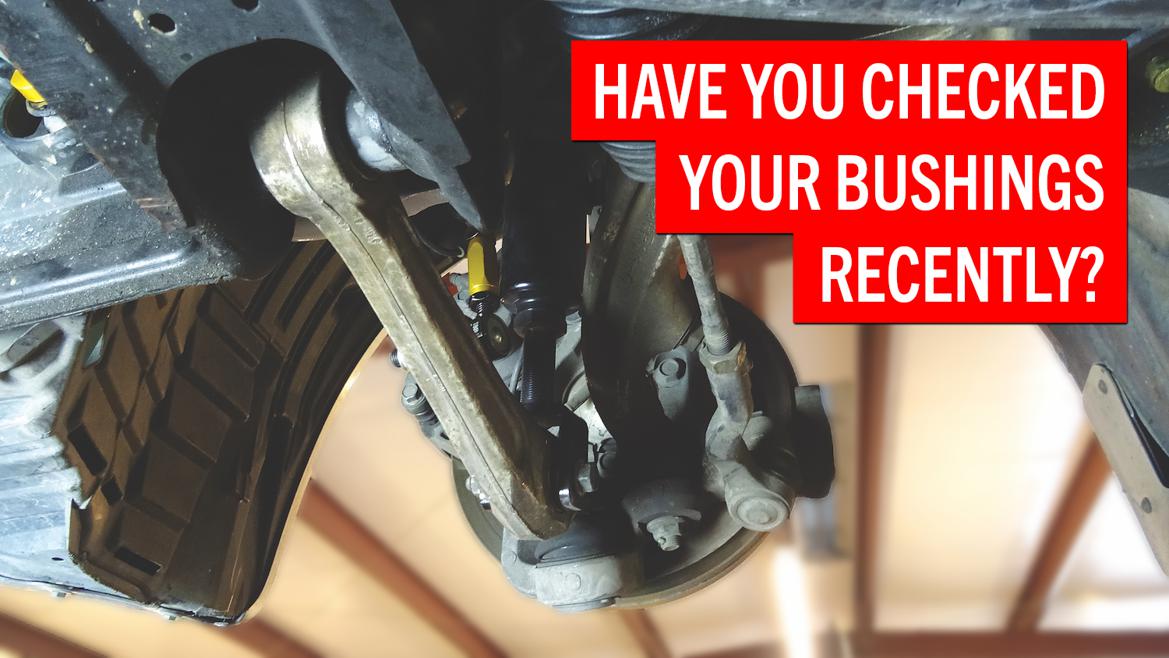I checked them recently, but never have I "chekced" them![]()


Photography Credit: J.G. Pasterjak
Many of us only notice a bushing when something goes wrong. This is how the manufacturers intended it. The reality is that bushings are one of the most important systems on your car. Simply put, they separate the part of your car that’s designed to move from the part that isn’t.
Obviously a car’s suspension is designed to move. That’s how it keeps the tire in contact with an ever-undulating road surface and provides some level of comfort for the occupants. The most precise way to allow the suspension components to move is to use simple pivots or bearings. The downside: Metal-on-metal connections transmit a great deal of noise, vibration and harshness from the road into the chassis. Solid pivots are also unforgiving of forces pushing them in directions they aren’t designed to move. Permanent damage can result from one firm wayward bump.
The typical solution for street cars? Hard rubber bushings with metallic sleeves. These allow suspension components to pivot in the proper arc, but they reduce noise and vibration. They also provide a degree of compliance in that they can deform and bounce back into shape when loads are applied. While this is a fine solution for a street car, in a competition situation when those loads increase, bushings can become a huge tuning frustration. They deform and can allow your suspension to move under cornering loads.
[How to Make Your Own Delrin and Urethane Bushings]
In many cases, this bushing deformation is simply a cost of doing business. In certain cases, though, it’s a huge liability. For example, let’s say we have a bushing that deforms under a cornering load. Think of that bushing as a tiny spring: Under load, it compresses; when the load is removed, it relaxes.
But if the bushing deforms so far that it can no longer compress, it effectively becomes solid. Imagine if your spring rates went from 500 lbs./in. to infinity in the middle of a corner. It’s a frustrating situation to deal with, and it becomes more of an issue as cornering loads increase with the addition of wide, sticky tires and a more competent suspension.

But there are times where compliance is a virtue. The front compression arm on a Nissan 350Z is a perfect example. The compression arm is the back half of the two-part lower control arm, which specializes in controlling front and rear movement of the hub. As such, it has a bushing oriented in so that the arm’s pivot is perpendicular to the ground. But this arm also needs to move perpendicular to the ground, so the bushing is designed with lots of compliance to allow the joint to rotate vertically. It’s a decent arrangement for a street car, but it becomes apparent pretty quickly that it’s a compromise at best for real performance.
[Project car: LS-swapped Nissan 350Z]
If we replace the bushing with something stiffer to limit the fore and aft compression, we create vertical resistance that effectively adds to the spring rate in an unpredictable fashion.
Can't check when it's solid aluminum or a heim...
I kid on the heims but they are a once a few thousand mile checked...
AnthonyGS (Forum Supporter) said:I wish harder durometer rubber bushings were commonly available for all performance cars.
This x100. After so many poly failures it seems the best logical solution is a rubber bushing with increased durometer/remove compliance voids.
Moog has a few different lines of replacement parts and ive found that some of them "fix" the bushing issues by making new full rubber bushings instead of the OE compliance void bushings.
Biggest one i found that made a huge difference was on our Elantra Champ Car.
Displaying 1-5 of 5 commentsView all comments on the GRM forums
You'll need to log in to post.